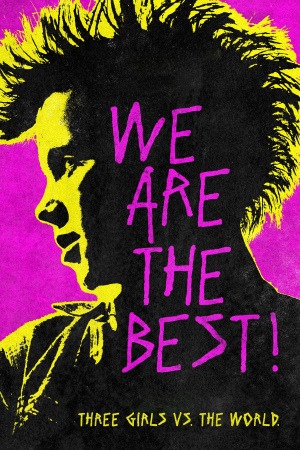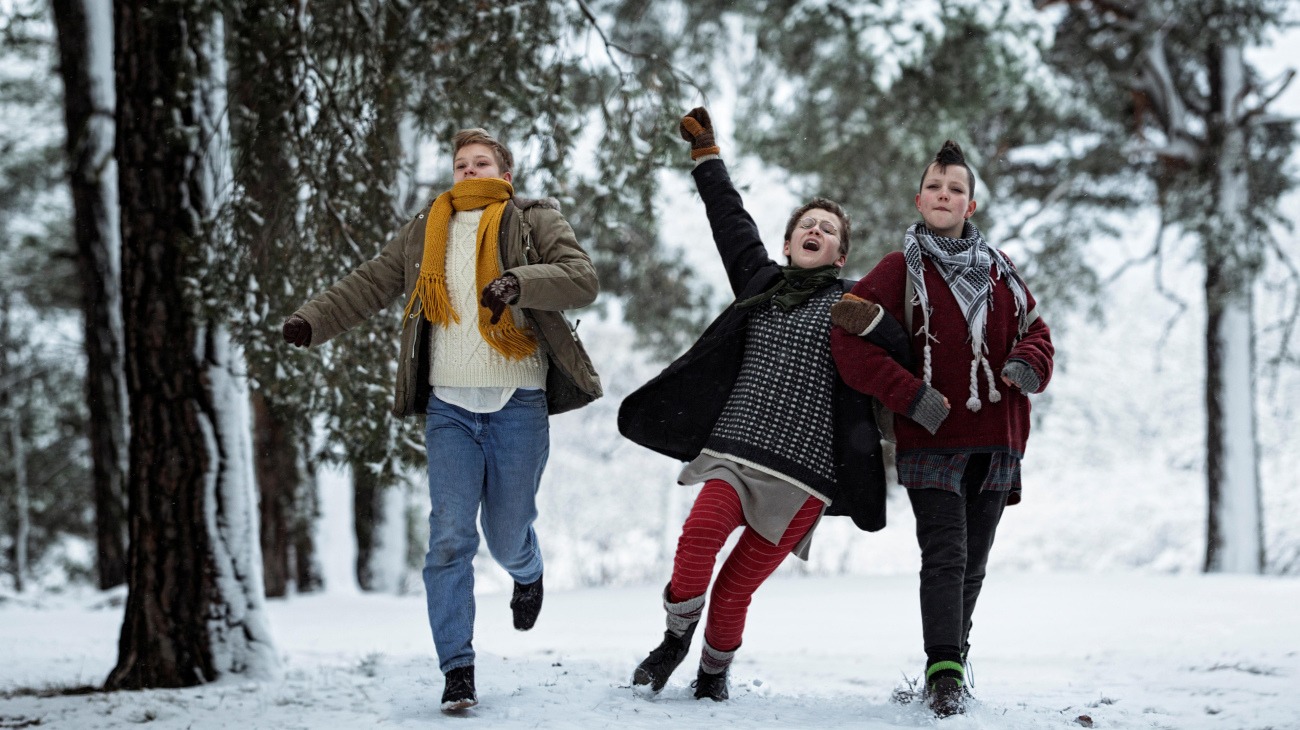
Punk rock girls
“Scandinavian social realism” and “fluffy character-driven comedy” are what you might call non-overlapping magisterial. But that’s not the sort of thing to stop Lukas Moodysson, whose seventh feature We Are the Best! marries exactly those two genres and does it with surprising ease and charm. As one of European cinema’s foremost humanists, Moodysson has always been prone to treating his characters with particular generosity and forgiveness, and the jump from something like Together, and its deft lightness of touch, to a full-on comic exploration of human behavior at the edges, is not such a very long one, perhaps. At any rate, We Are the Best! works like gangbusters; it’s perhaps a little bit too similar to the writer-director’s big breakthrough, Show Me Love from 1998, to feel as fresh and insouciant as it wants to, and it has the inevitable roughness that comes when a movie builds itself completely around young actors, but it’s so likable in its storytelling and so earthbound in its observations about the travails of early adolescence that it could overcome much stiffer problems than it has facing it.
Set in the early 1980s, the film is about the dream of punk, then on its last legs as a meaningful cultural force. The heroes are a pair of tween girls, androgynous Bobo (Mira Barkhammar) and mohawked, politically riled-up Klara (Mira Grosin), the latter of whom provides all the angry passion that drives the two friends to turn listening to music into an act of defiance against the system, the cultural rise of disco and new wave, and the old punks like Klara’s brother who gave up on punk when it started to fade out of fashion. On a whim, and to screw with some asshole teen boys playing clamorous rock in the local community center’s rehearsal space, the girls form a band to give vent to their disgust with the state of things. When it turns out that they can’t, between them, play a single note on any instrument, they finagle a talented religious schoolmate, Hedvig (Liv LeMoyne) into serving as their lead guitarist and teaching them about music on the way.
That’s about it as far as heated drama goes. There is, eventually, some small conflict between the three when boys enter the picture and Bobo and Klara set their eyes on the same one, but this is all in the grand tradition of European art house drama. That means low stakes, limited plot, and a focus instead on watching people’s behavior in an unforced, naturalistic state. The success of We Are the Best! comes, then, from its terrific depiction of three contrasting (but not conflicting) personalities, and their outsider status: as young people trying to force adults to treat them with any kind of dignity, as young women in a cultural context that favors men, as political activists surrounded by comfortable conformity and apathy. It’s clear enough from the way Moodysson, adapting a comic book by his wife Coco Moodysson, treats them that he’s pro-punk, pro-political engagement, and pro-feminism, though We Are the Best! never remotely turns into a tract. In fact, one of the best successes of the film is that it looks on the girls and their enthusiastic naïveté from a clearly adult perspective. There is a point at which their passion shades into silliness, and the film knows it; while it admires the fervor of youthful ideology, it also recognises the limited scope of that ideology. The tone doesn’t eulogise punk rock, but merely acknowledge that its passing left a void in which those who had a driven certitude that society wasn’t working needed to find their own voice, since that voice wasn’t being provided by the culture at large.
Ultimately, it’s a film about children becoming young people and finding their identity, rather than about the particular meaning or merits of those identities, and it adopts a most forgiving and loving position to the mistakes and dead-ends that process can consist of. It’s a coming-of-age story that’s honest and moving without being nostalgic in even the smallest degree, an enormously difficult pitfall for the genre to avoid, though one that the roughness of the film’s realistic aesthetic and its caustic punk soundtrack help to keep at bay even if Moodysson’s writing wasn’t so clear-eyed.
An altogether delightful, intimate character study that’s consistently funny without being flippant or insincere (the tone is overwhelmingly “we can laugh at these kids now because we did the same goofy things once upon a time”), and limited only in smallish ways. The acting could be better, is part of it: some of that is inherent to the writing, since the most overwrought character, Klara, results in the most frequently mis-aimed performance. There’s a lot of grounding that needs to be done to keep her political rants sounding like passionate beliefs instead of just repeated gobbledygook, and Grosin has some problems making that happen consistently. And then on the flipside, we have Hedvig, the most quiet and reflective of the girls, the one who is most based in watching and thinking and responding, and LeMoyne’s performance is the best, or at least the most stable. To be fair, the acting is, across the board, very good more often than not. But when the young performers are missing the mark, it’s pretty distracting and debilitating.
The other problem, and oh, how “problem” is a leading word, is the style: in the middle of the 2010s, we’ve hit a point where the low-fi handheld docu-realist aesthetic of European stories about the life of people of limited economic means has entirely run out of anything new to do or say. The script, the tone, and the acting are the important things here, and they are all solid and doing what they must. But We Are the Best! simply isn’t very interesting or enlightening to look at, feeling like the camerawork and editing are on autopilot for most of the time, and serving only to give a good foundation for the script to do its job. There’s of course nothing wrong with any of that, but for all its real pleasures and its touching, accessible humanity, if anybody responded to the first five minutes of the film by sighing “not this again?”, I would have to reply that, yes, that’s pretty much exactly right. It’s a film for seeing familiar things being done well, not for being surprised or challenged.
8/10
Set in the early 1980s, the film is about the dream of punk, then on its last legs as a meaningful cultural force. The heroes are a pair of tween girls, androgynous Bobo (Mira Barkhammar) and mohawked, politically riled-up Klara (Mira Grosin), the latter of whom provides all the angry passion that drives the two friends to turn listening to music into an act of defiance against the system, the cultural rise of disco and new wave, and the old punks like Klara’s brother who gave up on punk when it started to fade out of fashion. On a whim, and to screw with some asshole teen boys playing clamorous rock in the local community center’s rehearsal space, the girls form a band to give vent to their disgust with the state of things. When it turns out that they can’t, between them, play a single note on any instrument, they finagle a talented religious schoolmate, Hedvig (Liv LeMoyne) into serving as their lead guitarist and teaching them about music on the way.
That’s about it as far as heated drama goes. There is, eventually, some small conflict between the three when boys enter the picture and Bobo and Klara set their eyes on the same one, but this is all in the grand tradition of European art house drama. That means low stakes, limited plot, and a focus instead on watching people’s behavior in an unforced, naturalistic state. The success of We Are the Best! comes, then, from its terrific depiction of three contrasting (but not conflicting) personalities, and their outsider status: as young people trying to force adults to treat them with any kind of dignity, as young women in a cultural context that favors men, as political activists surrounded by comfortable conformity and apathy. It’s clear enough from the way Moodysson, adapting a comic book by his wife Coco Moodysson, treats them that he’s pro-punk, pro-political engagement, and pro-feminism, though We Are the Best! never remotely turns into a tract. In fact, one of the best successes of the film is that it looks on the girls and their enthusiastic naïveté from a clearly adult perspective. There is a point at which their passion shades into silliness, and the film knows it; while it admires the fervor of youthful ideology, it also recognises the limited scope of that ideology. The tone doesn’t eulogise punk rock, but merely acknowledge that its passing left a void in which those who had a driven certitude that society wasn’t working needed to find their own voice, since that voice wasn’t being provided by the culture at large.
Ultimately, it’s a film about children becoming young people and finding their identity, rather than about the particular meaning or merits of those identities, and it adopts a most forgiving and loving position to the mistakes and dead-ends that process can consist of. It’s a coming-of-age story that’s honest and moving without being nostalgic in even the smallest degree, an enormously difficult pitfall for the genre to avoid, though one that the roughness of the film’s realistic aesthetic and its caustic punk soundtrack help to keep at bay even if Moodysson’s writing wasn’t so clear-eyed.
An altogether delightful, intimate character study that’s consistently funny without being flippant or insincere (the tone is overwhelmingly “we can laugh at these kids now because we did the same goofy things once upon a time”), and limited only in smallish ways. The acting could be better, is part of it: some of that is inherent to the writing, since the most overwrought character, Klara, results in the most frequently mis-aimed performance. There’s a lot of grounding that needs to be done to keep her political rants sounding like passionate beliefs instead of just repeated gobbledygook, and Grosin has some problems making that happen consistently. And then on the flipside, we have Hedvig, the most quiet and reflective of the girls, the one who is most based in watching and thinking and responding, and LeMoyne’s performance is the best, or at least the most stable. To be fair, the acting is, across the board, very good more often than not. But when the young performers are missing the mark, it’s pretty distracting and debilitating.
The other problem, and oh, how “problem” is a leading word, is the style: in the middle of the 2010s, we’ve hit a point where the low-fi handheld docu-realist aesthetic of European stories about the life of people of limited economic means has entirely run out of anything new to do or say. The script, the tone, and the acting are the important things here, and they are all solid and doing what they must. But We Are the Best! simply isn’t very interesting or enlightening to look at, feeling like the camerawork and editing are on autopilot for most of the time, and serving only to give a good foundation for the script to do its job. There’s of course nothing wrong with any of that, but for all its real pleasures and its touching, accessible humanity, if anybody responded to the first five minutes of the film by sighing “not this again?”, I would have to reply that, yes, that’s pretty much exactly right. It’s a film for seeing familiar things being done well, not for being surprised or challenged.
8/10






